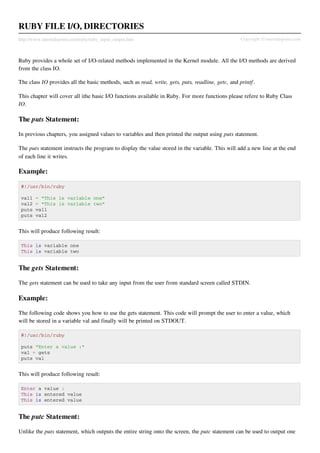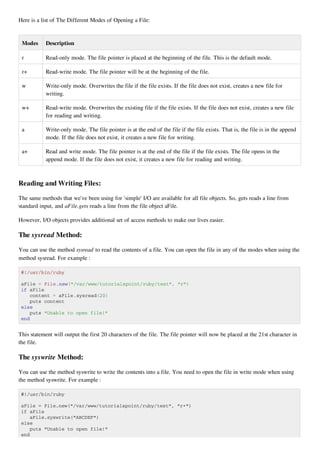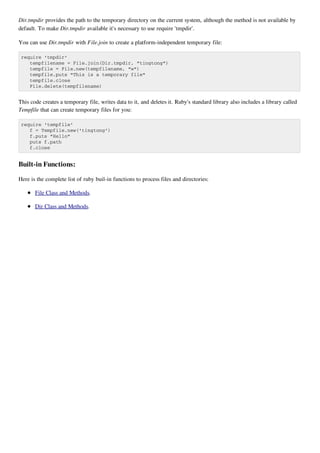20 ruby input output
- 1. RUBY FILE I/O, DIRECTORIES http://www.tutorialspoint.com/ruby/ruby_input_output.htm Copyright © tutorialspoint.com Ruby provides a whole set of I/O-related methods implemented in the Kernel module. All the I/O methods are derived from the class IO. The class IO provides all the basic methods, such as read, write, gets, puts, readline, getc, and printf . This chapter will cover all ithe basic I/O functions available in Ruby. For more functions please refere to Ruby Class IO. The puts Statement: In previous chapters, you assigned values to variables and then printed the output using puts statement. The puts statement instructs the program to display the value stored in the variable. This will add a new line at the end of each line it writes. Example: #!/usr/bin/ruby val1 = "This is variable one" val2 = "This is variable two" puts val1 puts val2 This will produce following result: This is variable one This is variable two The gets Statement: The gets statement can be used to take any input from the user from standard screen called STDIN. Example: The following code shows you how to use the gets statement. This code will prompt the user to enter a value, which will be stored in a variable val and finally will be printed on STDOUT. #!/usr/bin/ruby puts "Enter a value :" val = gets puts val This will produce following result: Enter a value : This is entered value This is entered value The putc Statement: Unlike the puts statement, which outputs the entire string onto the screen, the putc statement can be used to output one
- 2. character at a time. Example: The output of the following code is just the character H: #!/usr/bin/ruby str="Hello Ruby!" putc str This will produce following result: H The print Statement: The print statement is similar to the puts statement. The only difference is that the puts statement goes to the next line after printing the contents, whereas with the print statement the cursor is positioned on the same line. Example: #!/usr/bin/ruby print "Hello World" print "Good Morning" This will produce following result: Hello WorldGood Morning Opening and Closing Files: Until now, you have been reading and writing to the standard input and output. Now we will see how to play with actual data files. The File.new Method: You can create a File object using File.new method for reading, writing, or both, according to the mode string. Finally you can use File.close method to close that file. Syntax: aFile = File.new("filename", "mode") # ... process the file aFile.close The File.open Method: You can use File.open method to create a new file object and assign that file object to a file. However, there is one difference in between File.open and File.new methods. The difference is that the File.open method can be associated with a block, whereas you cannot do the same using the File.new method. File.open("filename", "mode") do |aFile| # ... process the file end
- 3. Here is a list of The Different Modes of Opening a File: Modes Description r Read-only mode. The file pointer is placed at the beginning of the file. This is the default mode. r+ Read-write mode. The file pointer will be at the beginning of the file. w Write-only mode. Overwrites the file if the file exists. If the file does not exist, creates a new file for writing. w+ Read-write mode. Overwrites the existing file if the file exists. If the file does not exist, creates a new file for reading and writing. a Write-only mode. The file pointer is at the end of the file if the file exists. That is, the file is in the append mode. If the file does not exist, it creates a new file for writing. a+ Read and write mode. The file pointer is at the end of the file if the file exists. The file opens in the append mode. If the file does not exist, it creates a new file for reading and writing. Reading and Writing Files: The same methods that we've been using for 'simple' I/O are available for all file objects. So, gets reads a line from standard input, and aFile.gets reads a line from the file object aFile. However, I/O objects provides additional set of access methods to make our lives easier. The sysread Method: You can use the method sysread to read the contents of a file. You can open the file in any of the modes when using the method sysread. For example : #!/usr/bin/ruby aFile = File.new("/var/www/tutorialspoint/ruby/test", "r") if aFile content = aFile.sysread(20) puts content else puts "Unable to open file!" end This statement will output the first 20 characters of the file. The file pointer will now be placed at the 21st character in the file. The syswrite Method: You can use the method syswrite to write the contents into a file. You need to open the file in write mode when using the method syswrite. For example : #!/usr/bin/ruby aFile = File.new("/var/www/tutorialspoint/ruby/test", "r+") if aFile aFile.syswrite("ABCDEF") else puts "Unable to open file!" end
- 4. This statement will write "ABCDEF" into the file. The each_byte Method: This method belongs to the class File. The method each_byte is always associated with a block. Consider the following code sample: : #!/usr/bin/ruby aFile = File.new("/var/www/tutorialspoint/ruby/test", "r") if aFile aFile.syswrite("ABCDEF") aFile.each_byte {|ch| putc ch; putc ?. } else puts "Unable to open file!" end Characters are passed one by one to the variable ch and then displayed on the screen as follows: T.h.i.s. .i.s. .l.i.n.e. .o.n.e. .T.h.i.s. .i.s. .l.i.n.e. .t.w.o. .T.h.i.s. .i.s. .l.i.n.e. .t.h.r.e.e. .A.n.d. .s.o. .o.n....... The IO.readlines Method: The class File is a subclass of the class IO. The class IO also has some methods which can be used to manipulate files. One of the IO class methods is IO.readlines. This method returns the contents of the file line by line. The following code displays the use of the method IO.readlines: #!/usr/bin/ruby arr = IO.readlines("/var/www/tutorialspoint/ruby/test") puts arr[0] puts arr[1] In this code, the variable arr is an array. Each line of the file test will be an element in the array arr. Therefore, arr[0] will contain the first line, whereas arr[1] will contain the second line of the file. The IO.foreach Method: This method also returns output line by line. The difference between the method foreach and the method readlines is that the method foreach is associated with a block. However, unlike the method readlines, the method foreach does not return an array. For example: #!/usr/bin/ruby IO.foreach("test"){|block| puts block} This code will pass the contents of the file test line by line to the variable block, and then the output will be displayed on the screen. Renaming and Deleting Files: You can rename and delete files programmatically with Ruby with the rename and delete methods. Following is the example to rename an existing file test1.txt:
- 5. #!/usr/bin/ruby # Rename a file from test1.txt to test2.txt File.rename( "test1.txt", "test2.txt" ) Following is the example to delete an existing file test2.txt: #!/usr/bin/ruby # Delete file test2.txt File.delete("text2.txt") File Modes and Ownership: Use the chmod method with a mask to change the mode or permissions/access list of a file: Following is the example to change mode of an existing file test.txt to a mask value: #!/usr/bin/ruby file = File.new( "test.txt", "w" ) file.chmod( 0755 ) Following is the table which can help you to choose different mask for chmod method: Mask Description 0700 rwx mask for owner 0400 r for owner 0200 w for owner 0100 x for owner 0070 rwx mask for group 0040 r for group 0020 w for group 0010 x for group 0007 rwx mask for other 0004 r for other 0002 w for other 0001 x for other 4000 Set user ID on execution 2000 Set group ID on execution 1000 Save swapped text, even after use
- 6. File Inquiries: The following command tests whether a file exists before opening it: #!/usr/bin/ruby File.open("file.rb") if File::exists?( "file.rb" ) The following command inquire whether the file is really a file: #!/usr/bin/ruby # This returns either true or false File.file?( "text.txt" ) The following command finds out if it given file name is a directory: #!/usr/bin/ruby # a directory File::directory?( "/usr/local/bin" ) # => true # a file File::directory?( "file.rb" ) # => false The following command finds whether the file is readable, writable or executable: #!/usr/bin/ruby File.readable?( "test.txt" ) # => true File.writable?( "test.txt" ) # => true File.executable?( "test.txt" ) # => false The following command finds whether the file has zero size or not: #!/usr/bin/ruby File.zero?( "test.txt" ) # => true The following command returns size of the file : #!/usr/bin/ruby File.size?( "text.txt" ) # => 1002 The following command can be used to find out a type of file : #!/usr/bin/ruby File::ftype( "test.txt" ) # => file The ftype method identifies the type of the file by returning one of the following: file, directory, characterSpecial, blockSpecial, fifo, link, socket, or unknown. The following command can be used to find when a file was created, modified, or last accessed : #!/usr/bin/ruby File::ctime( "test.txt" ) # => Fri May 09 10:06:37 -0700 2008 File::mtime( "text.txt" ) # => Fri May 09 10:44:44 -0700 2008 File::atime( "text.txt" ) # => Fri May 09 10:45:01 -0700 2008
- 7. Directories in Ruby: All files are contained within various directories, and Ruby has no problem handling these too. Whereas the File class handles files, directories are handled with the Dir class. Navigating Through Directories: To change directory within a Ruby program, use Dir.chdir as follows. This example changes the current directory to /usr/bin. Dir.chdir("/usr/bin") You can find out what the current directory is with Dir.pwd: puts Dir.pwd # This will return something like /usr/bin You can get a list of the files and directories within a specific directory using Dir.entries: puts Dir.entries("/usr/bin").join(' ') Dir.entries returns an array with all the entries within the specified directory. Dir.foreach provides the same feature: Dir.foreach("/usr/bin") do |entry| puts entry end An even more concise way of getting directory listings is by using Dir's class array method: Dir["/usr/bin/*"] Creating a Directory: The Dir.mkdir can be used to create directories: Dir.mkdir("mynewdir") You can also set permissions on a new directory (not one that already exists) with mkdir: NOTE: The mask 755 sets permissions owner, group, world [anyone] to rwxr-xr-x where r = read, w = write, and x = execute. Dir.mkdir( "mynewdir", 755 ) Deleting a Directory: The Dir.delete can be used to delete a directory. The Dir.unlink and Dir.rmdir perform exactly the same function and are provided for convenience. Dir.delete("testdir") Creating Files & Temporary Directories: Temporary files are those that might be created briefly during a program's execution but aren't a permanent store of information.
- 8. Dir.tmpdir provides the path to the temporary directory on the current system, although the method is not available by default. To make Dir.tmpdir available it's necessary to use require 'tmpdir'. You can use Dir.tmpdir with File.join to create a platform-independent temporary file: require 'tmpdir' tempfilename = File.join(Dir.tmpdir, "tingtong") tempfile = File.new(tempfilename, "w") tempfile.puts "This is a temporary file" tempfile.close File.delete(tempfilename) This code creates a temporary file, writes data to it, and deletes it. Ruby's standard library also includes a library called Tempfile that can create temporary files for you: require 'tempfile' f = Tempfile.new('tingtong') f.puts "Hello" puts f.path f.close Built-in Functions: Here is the complete list of ruby buil-in functions to process files and directories: File Class and Methods. Dir Class and Methods.




![This statement will write "ABCDEF" into the file.
The each_byte Method:
This method belongs to the class File. The method each_byte is always associated with a block. Consider the following
code sample: :
#!/usr/bin/ruby
aFile = File.new("/var/www/tutorialspoint/ruby/test", "r")
if aFile
aFile.syswrite("ABCDEF")
aFile.each_byte {|ch| putc ch; putc ?. }
else
puts "Unable to open file!"
end
Characters are passed one by one to the variable ch and then displayed on the screen as follows:
T.h.i.s. .i.s. .l.i.n.e. .o.n.e.
.T.h.i.s. .i.s. .l.i.n.e. .t.w.o.
.T.h.i.s. .i.s. .l.i.n.e. .t.h.r.e.e.
.A.n.d. .s.o. .o.n.......
The IO.readlines Method:
The class File is a subclass of the class IO. The class IO also has some methods which can be used to manipulate files.
One of the IO class methods is IO.readlines. This method returns the contents of the file line by line. The following
code displays the use of the method IO.readlines:
#!/usr/bin/ruby
arr = IO.readlines("/var/www/tutorialspoint/ruby/test")
puts arr[0]
puts arr[1]
In this code, the variable arr is an array. Each line of the file test will be an element in the array arr. Therefore, arr[0]
will contain the first line, whereas arr[1] will contain the second line of the file.
The IO.foreach Method:
This method also returns output line by line. The difference between the method foreach and the method readlines is
that the method foreach is associated with a block. However, unlike the method readlines, the method foreach does not
return an array. For example:
#!/usr/bin/ruby
IO.foreach("test"){|block| puts block}
This code will pass the contents of the file test line by line to the variable block, and then the output will be displayed
on the screen.
Renaming and Deleting Files:
You can rename and delete files programmatically with Ruby with the rename and delete methods.
Following is the example to rename an existing file test1.txt:](https://image.slidesharecdn.com/20rubyinputoutput-130204175545-phpapp01/85/20-ruby-input-output-4-320.jpg)


![Directories in Ruby:
All files are contained within various directories, and Ruby has no problem handling these too. Whereas the File class
handles files, directories are handled with the Dir class.
Navigating Through Directories:
To change directory within a Ruby program, use Dir.chdir as follows. This example changes the current directory to
/usr/bin.
Dir.chdir("/usr/bin")
You can find out what the current directory is with Dir.pwd:
puts Dir.pwd # This will return something like /usr/bin
You can get a list of the files and directories within a specific directory using Dir.entries:
puts Dir.entries("/usr/bin").join(' ')
Dir.entries returns an array with all the entries within the specified directory. Dir.foreach provides the same feature:
Dir.foreach("/usr/bin") do |entry|
puts entry
end
An even more concise way of getting directory listings is by using Dir's class array method:
Dir["/usr/bin/*"]
Creating a Directory:
The Dir.mkdir can be used to create directories:
Dir.mkdir("mynewdir")
You can also set permissions on a new directory (not one that already exists) with mkdir:
NOTE: The mask 755 sets permissions owner, group, world [anyone] to rwxr-xr-x where r = read, w = write, and x =
execute.
Dir.mkdir( "mynewdir", 755 )
Deleting a Directory:
The Dir.delete can be used to delete a directory. The Dir.unlink and Dir.rmdir perform exactly the same function and
are provided for convenience.
Dir.delete("testdir")
Creating Files & Temporary Directories:
Temporary files are those that might be created briefly during a program's execution but aren't a permanent store of
information.](https://image.slidesharecdn.com/20rubyinputoutput-130204175545-phpapp01/85/20-ruby-input-output-7-320.jpg)


























































































